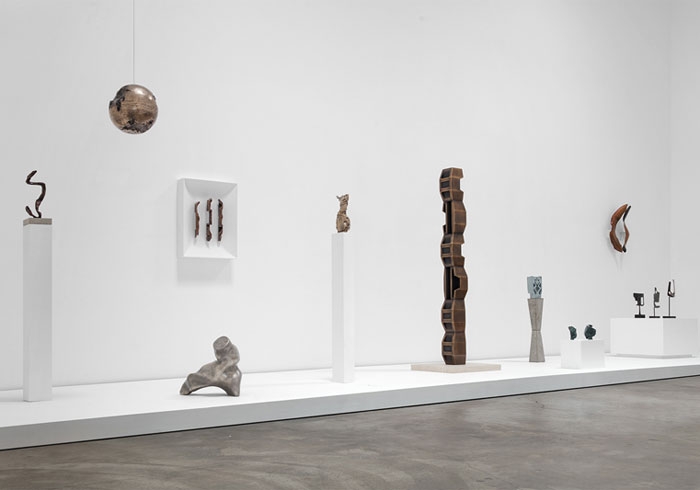Anat Ebgi, Los Angeles, 9 June – 15 July 2017
Insectile, mechanical and almost totally mysterious, An Te Liu’s sculptures look like alien cargo-cult relics and ritual masks from some postapocalyptic religion. Modernist body parts, sliced and curved, jaunt and squirm on clean plinths and from mounts on the smooth walls. A battered disco-ball like a dead moon hangs above it all. The ball has its own story, but most of these shapely sculptures come by way of artistic intervention and bronze casting from polystyrene repurposed from old packaging – known more commonly by chemical manufacturer Dow’s proprietary epithet Styrofoam.
Expanded into odd geometries to slide into boxes and protect products almost as disposable as their packaging, this inventively nonbiodegradable material will easily outlive the last unlucky human. Even if it easily chips and breaks in your hand, Styrofoam (encased and floating amidst the rest of our garbage) might be one of humanity’s most lasting legacies, making it all the more fitting that Liu elevates these discards into odd monuments, riffing on this altogether-disposable material with classical elegance and modernist abstraction (along with a wink and a smile).
What ideals and essential truths can be cut from an easily tossed but enduring modern material? While some works entice with smoothed skins and polished surfaces, others wear a weathered patina, a rough texture that makes them look curiously ancient (or at least resilient enough to become so). Staged on a long platform that hugs the long wall of a narrow gallery, these sculptures look like an anthropologist’s reliquary or funereal statuary, a study and memorial dedicated to the tragicomic theatre of our own trashy hubris.
Some of the found Styrofoam required only bronzing without intervention; its odd bodies were already so futuristic and menacing, like some of Lee Bontecou’s more severe wallworks. But others were carved with a hotwire before finding their way to the foundry. These sculptures evoke some of the natural forms found in Isamu Noguchi’s designs or hunks of the abstracted figures of Henry Moore or Umberto Boccioni, but stare long enough and you can see the lingering shape of packaging and the scars of the artist’s shaping it just so. The gravitas of these things as elegant objects tenses against their humble substrate’s toxic reputation. The artist plays with the found foam in particular ways, slipping in sly allusions and soft jokes in their titles. The idealistic classicism of Ancient Greece gets namechecked in Eidolon VII–IV (2016) and Eudaemon (2017), both of which are spirits, as does the chortlingly punny Edifice Complex (2016). The name for the hanging bronzed disco ball (dated 2017) pithily punctuates the whole show: The Party’s Over.
From the September 2017 issue of ArtReview
